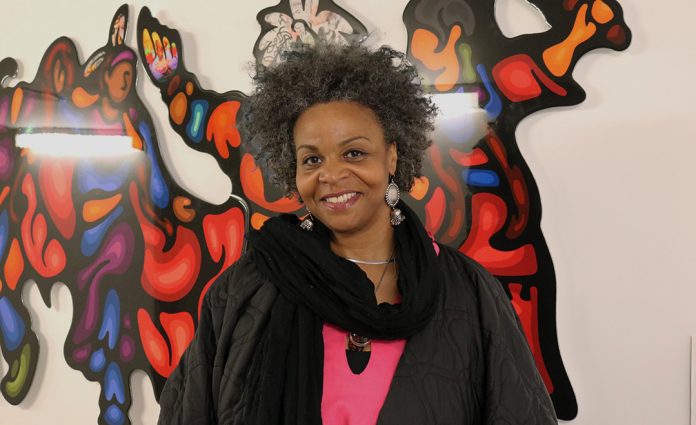Georgia Fullerton has been living artfully for as long as she can remember.
Fullerton is a Jamaican-Canadian visual artist, expressive arts therapist, arts educator, and public speaker. With over 30 years of experience making art, she says she’s had an interest in art since a very young age.
“I started making art around, I’ll just say from the day I was born, but I’ll be realistic and say around age eight or nine,” she says.
Her parents greatly influenced her artistic journey, as they enrolled her in many art classes as a kid. “I was always that kid that would be hidden away in my room, either reading Judy Blume or drawing or something like that,” she says.
Fullerton was born in Jamaica and moved to Canada in 1967. She studied visual arts at Red Deer College in Red Deer, Alberta, and earned a Bachelor of Arts degree in 1991 at York University in Toronto, Ontario.
She then moved to Durham Region in 2010 and now lives in Ajax. The years 2010-2011 played a significant role in her art career, as her style began to shift and she evolved past figurative and portraiture art.
“I started to understand a little bit more about therapeutic arts, and then my art actually changed,” she says. “So right now, I’m doing expressive abstract art and I’m loving it. [I’m also loving] a little bit of mixed media.”
It was during this time that she was also introduced to expressive arts therapy. “Expressive arts therapy, it was like a gift to me back in 2010,” she says.
Fullerton experienced a traumatic event of a one-time physical abuse situation within her relationship that year, but she used her pain to her artistic advantage.
“What was integral about it and what made me think that you know what, this has to happen along my path, as warped as that may sound,” she says. “But what I reaped from that was the fact that I can look at art differently.”
She says her paintbrush became her healing stick, and through that trauma, she developed a different relationship with art making, with herself, and with other people.
“So I asked the question, how can this help me? And how can it help others?” By chance, Fullerton ended up meeting someone who was studying expressive arts therapy, and she decided to take a chance on it.
“And the best part of it is that I realized I had all these other resources within me,” she says. “Not just painting and drawing, but how I use my voice, how I connect with other people, how I relate to others, so it’s been fantastic.”
Fullerton now works as an expressive arts therapist with a small private practice at the Station Gallery in Whitby. She also facilitates healing art workshops online.
She is also the first Black visual artist to sit on the board of directors of the Robert McLaughlin Gallery and the founder of the Durham Black Artists’ Collective (DBAC).
Fullerton says it means a lot to her to be the first Black visual artist to sit on the board. “For me it means that I have arrived to a certain extent, and I don’t necessarily mean just as a Black woman, I mean as a professional artist, I have arrived.”
“There are institutions all over the world that can recognize you,” she says. “But when you’re recognized in your own community and as a Black female, we don’t get our voices heard often, especially artists, I would say, or any creatives.”
However, with this new responsibility came some challenges. Fullerton says she had to give herself permission to speak up about showcasing and highlighting marginalized artists who don’t have a platform.
“So it didn’t necessarily pose a challenge for me, but there was some hesitancy in how much can I say and not say,” she says. “But I think overall most of the challenges come [from] me learning all the aspects of governance when it comes to sitting on the board.”
Being the founder of the Durham Black Artists Collective (DBAC) also comes with its own challenges, she says.
Fullerton started the DBAC in 2016 once she realized that there was no governing body or collective of Black artists in the Durham Region.
“For the collective, we’re dedicated to highlighting and showcasing Black Canadian and Caribbean artists in Durham Region,” she says. “We want to be able to hold professional workshops, we want to be able to also exhibit our work and just let the world know that we’re here.”
Spreading awareness about the collective and connecting with all the Black artists in the Durham Region has been somewhat of a challenge.
Another obstacle Fullerton has faced is establishing a brick-and-mortar location for the collective to meet and host professional development workshops. “We’re really hoping to speak to that challenge, and find some solutions around establishing a hub, establishing a place where the Durham Black Artist Collective can actually thrive,” she says.
Meanwhile, Fullerton is also working towards bringing her idea of a wellness network to life. Create My Art Story is for Big-C and Small-C creatives who want to expand their art practice into more of their everyday life as well as monetize it in a business.
As a woman who wears many hats, art always remains at the centre of her personal and professional life, and she makes a conscious effort to continue to live artfully.




